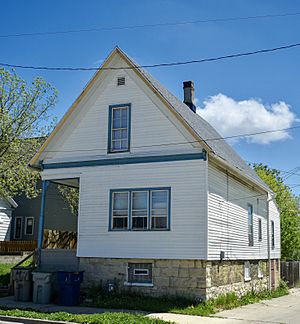Lloyd Barbee facts for kids
Quick facts for kids
Lloyd Barbee
|
|
|---|---|
| Member of the Wisconsin State Assembly | |
| In office January 1965 – January 3, 1977 |
|
| Succeeded by | Marcia P. Coggs |
| Constituency | 6th district (1965–1973) 18th district (1973–1977) |
| Personal details | |
| Born |
Lloyd Augustus Barbee
August 17, 1925 Memphis, Tennessee, U.S. |
| Died | December 29, 2002 (aged 77) Milwaukee, Wisconsin, U.S. |
| Political party | Democratic |
| Education | LeMoyne–Owen College (BA) University of Wisconsin–Madison (JD) |
| Military service | |
| Branch/service | |
| Years of service | 1943–1946 |
Lloyd Augustus Barbee (born August 17, 1925 – died December 29, 2002) was an important American lawyer and politician. He worked hard to make sure everyone had equal rights. Barbee is best known for leading the fight to end segregation in the public schools of Milwaukee, Wisconsin. Segregation meant that Black and white students went to separate schools. He was a member of the Democratic Party.
Contents
Who Was Lloyd Barbee?
Lloyd Barbee was born in Memphis, Tennessee. When he was just twelve years old, he joined the NAACP. This group works to ensure equal rights for all people.
Barbee's Education and Military Service
Barbee served in the United States Navy from 1943 to 1946. After his military service, he went to college. In 1949, he earned a degree in economics from LeMoyne–Owen College. This college was for Black students at the time.
He then started law school at the University of Wisconsin–Madison. However, he left for a while because of unfair treatment due to his race. He later returned to finish his studies. In 1955, he became the president of the NAACP chapter in Madison. He completed law school in 1956.
Fighting for Equal Schools
In 1962, Barbee moved to Milwaukee, Wisconsin. At that time, Milwaukee was very divided by race. Black and white people often lived in separate neighborhoods. This also meant their schools were separate.
Challenging School Segregation
In 1963, Barbee began working with the NAACP to challenge the Milwaukee Public Schools (MPS). He argued that the schools needed to be integrated. This meant that students of all races should attend school together.
The school system said that the separation was not their fault. They claimed it was because people lived in different neighborhoods. Barbee disagreed. He believed the school policies made the problem worse.
Organizing for Change
To fight this, Barbee helped create the Milwaukee United School Integration Committee (MUSIC). This group organized protests to bring attention to the issue. They held school boycotts, where students stayed home from school. They also blocked school buses to show how serious the problem was.
Becoming a State Politician
In 1964, Barbee decided to run for office. He wanted to represent Milwaukee in the Wisconsin State Assembly. He won the election. From 1965 to 1977, he was the only African-American person in the state legislature.
The Landmark Lawsuit
The protests and boycotts did not convince the Milwaukee school board to change. So, in 1965, Barbee took a new step. He filed a federal lawsuit called Amos et al. v. Board of School Directors of the City of Milwaukee.
The Court Battle Begins
Barbee argued that MPS's policy of neighborhood schools actually kept schools separate. He and volunteers from MUSIC gathered research to prove this. The lawsuit went on for many years. Barbee often worked alone against the school system's lawyers.
A Victory for Integration
Finally, in 1976, federal judge John W. Reynolds Jr. made a decision. He agreed with Barbee. Judge Reynolds stated that segregation existed in Milwaukee schools. He also said that the school system had intentionally created and maintained it.
MPS appealed this decision all the way to the Supreme Court. But the Supreme Court supported Judge Reynolds's judgment. This meant Barbee had won his case. In 1979, MPS agreed to change its policies. They began working to integrate their schools.
Later Years and Legacy
After his time in the state legislature, Barbee continued his law practice. From 1978 to 2000, he taught in the Africology department at the University of Wisconsin–Milwaukee. He kept working for justice and social change in Milwaukee until he passed away in 2002. Lloyd Barbee's efforts made a lasting impact on civil rights and education.


